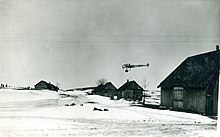Feldflieger Abteilung (FFA, Field Flying Detachment) was the title of the pioneering field aviation units of Die Fliegertruppen des deutschen Kaiserreiches (The Air Forces of the German Empire) formed in 1912, which became the Luftstreitkräfte (German air service) on 8 October 1916, during the First World War.
Die Fliegertruppen
The Fliegertruppen des deutschen Kaiserreiches, the aerial service of the Deutsches Heer, the Army of the German Empire was formed in 1912 when its organisation was laid down. Five new Flieger Bataillone (Aviation Battalions) with four companies each began forming in 1913. Four of the new units were created as part of the Communications Branch of the Prussian Army and one by the Bavarian Army; Saxony formed a detachment that was attached to a Prussian unit. The Bataillone were administrative units to provide flights for each army and corps HQ. At first aircraft were transported with armies, being assembled when they were needed but after one aircraft came apart in the air, killing the crew, the practise was abolished. The rest of the aircraft were modified to make them less likely to kill their crews. When 1914 began there was a shortage of aircraft and pilots. By the summer the shortage had been alleviated by new pilots trained by flying schools. The use of its aircraft for tactical reconnaissance was established by the German Army in its annual exercise in June 1911. Early use was limited to providing post-flight situation reports.
Flieger Bataillone: 1914
| Army | Stations | Attached to |
|---|---|---|
| Prussian Flieger Bataillon Nr 1 | Döberitz: HQ and 1 Kompanie, Jüterbog: 2 Kompanie, Großenhain: 3 (Saxon) Kompanie | Gardekorps |
| Prussian Flieger Bataillon Nr 2 | Posen: HQ and 1 Kompanie, Graudenz: 2 Kompanie, Königsberg: 3 Kompanie | V Korps |
| Prussian Flieger Bataillon Nr 3 | Köln: HQ and 1 Kompanie, Hannover: 2 Kompanie, Truppenübungsplatz (Proving ground), Darmstadt: 3 Kompanie | VIII Korps |
| Prussian Flieger Bataillon Nr 4 | Straßburg: HQ and 1 Kompanie, Metz: 2 Kompanie, Freiburg: 3 Kompanie | XV Korps |
| Bavarian Luft-und-Kraftfahrer Bataillon | Bavarian Aviation and Motor Battalion München | I Bavarian Korps |
| Bavarian Flieger Bataillon | Oberschleißheim | I Bavarian Korps |
First World War

At the start of the First World War, there were thirty-three FFA (three Bavarian), one allocated to each of the eight Army Headquarters and one to each of the twenty-five regular Corps Headquarters and six Festungflieger Abteilungen (Fortress Flying Detachments, one Bavarian) for the local defence of towns. Each FFA, having a number usually matching that of the army group it was assigned to, was equipped with either six Idflieg Category A (unarmed monoplane) or Category B (unarmed biplane) two-seater aircraft for short-range reconnaissance, photographic reconnaissance and artillery-observation. Longer-range flights being left to Zeppelins. By March 1915 the number of Feldflieger Abteilungen had doubled and the specialisation of fighter and bomber units, known as Jasta and Kampfgeschwader, respectively, had emerged but not forming formally under such names until the reorganisation of Die Fliegertruppen and its renaming as the Luftstreitkräfte on 8 October 1916.
FFA
| Unit No. | Location | Attachment | Notable Personnel |
|---|---|---|---|
| 6b | Bühl airfield, near Saarburg | Bavarian | Kurt Wintgens, Friedrich Marnet |
| 9b | Bavarian | ||
| 10 | Vrizy | Max Immelmann | |
| 23 | Roupy | Hans Joachim Buddecke, Ernst Freiherr von Althaus, Rudolf Berthold | |
| 48 | Mülhausen | Kurt Wintgens | |
| 62 | La Brayelle, Douai | Oswald Boelcke, Max Immelmann, Otto Parschau |
Notes
Footnotes
- Wyngarden 2006, p. 6.
- Sumner 2005, pp. 3–4.
- Sumner 2005, p. 4.
- Cowin 2000, p. 13.
- ^ Rimell 1985, p. 5.
- Franks, Bailey & Guest 1993, p. 12.
References
- Cowin, H. W. (2000). German and Austrian Aviation of World War I. Oxford: Osprey. ISBN 1-84176-069-2.
- Franks, Norman; Bailey, Frank; Guest, Russell (1993). Above the Lines: A Complete Record of the Fighter Aces of the German Air Service, Naval Air Service and Flanders Marine Corps, 1914–1918. London: Grub Street. ISBN 0-948817-73-9.
- Rimell, Ray (1985). The German Army Air Service in World War I. Vintage Warbirds (No. 2). London: Arms and Armour Press (Lionel Leventhal). ISBN 0-85368-694-7.
- Sumner, Ian (2005). German Air Forces 1914–1918. Elite (No. 135). Oxford: Osprey. ISBN 1-84176-924-X.
- Wyngarden, Greg van (2006). Early German Aces of World War I. Oxford: Osprey. ISBN 1-84176-997-5.
Further reading
- Hoeppner, E. W. von (1994) . Deutschlands Krieg in der Luft: Ein Rückblick auf die Entwicklung und die Leistungen unserer Heeres-Luftstreitkräfte im Weltkriege [Germany's War in the Air: A Review of the Development and the Achievements of our Army Air Force in the World War] (in German). Translated by Larned, J. Hawley (hbk. facs. repr. Battery Press ed.). Leipzig: K. F. Koehle. ISBN 0-89839-195-4.
- Neumann, G. P. (1920). Die deutschen Luftstreitkräfte im Weltkriege [The German Air Force in the Great War] (in German). Translated by Gurdon, J. E. (Hodder & Stoughton, London ed.). Berlin: Mittler. OCLC 39823845.
- O'Connor, M. (2001). Airfields & Airmen – Ypres. London: Leo Cooper. ISBN 0-85052-753-8.
- Imperial German Army Air Service
- German military aviation
- Disbanded air forces
- Army aviation units and formations
- Aviation in World War I
- German Army (German Empire)
- German Empire in World War I
- Military history of Germany
- Military of the German Empire
- Military of the German Empire by branch
- 20th-century German aviation